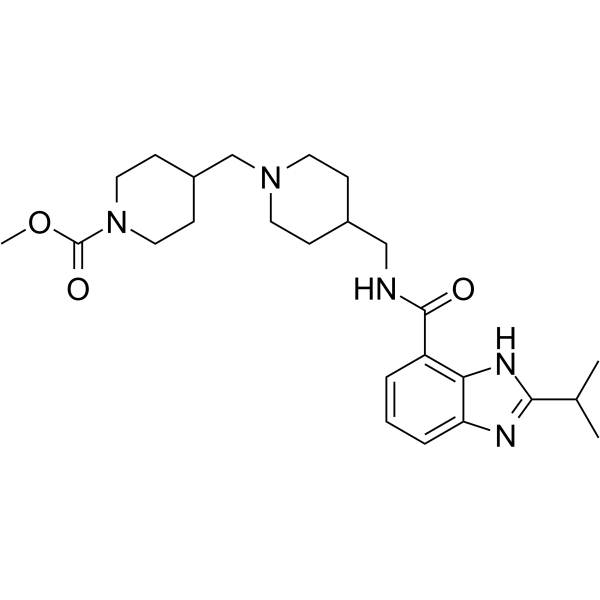916075-84-8
| Name | Tak-954 |
|---|---|
| Synonyms |
Tak-954
TD-8954 1-Piperidinecarboxylic acid, 4-[[4-[[[[2-(1-methylethyl)-1H-benzimidazol-4-yl]carbonyl]amino]methyl]-1-piperidinyl]methyl]-, methyl ester Methyl 4-{[4-({[(2-isopropyl-1H-benzimidazol-4-yl)carbonyl]amino}methyl)-1-piperidinyl]methyl}-1-piperidinecarboxylate |
| Description | Felcisetrag (TD-8954) is an orally active, potent and selective 5-HT4 receptor agonist with gastrointestinal prokinetic properties. Felcisetrag has high affinity (pKi =9.4) for human 5-HT4(c) receptors. |
|---|---|
| Related Catalog | |
| Target |
huamn 5-HT4(c) Receptor:9.4 (pKi) |
| In Vitro | Felcisetrag produces an elevation of cAMP in HEK-293 cells expressing the h5-HT4(c) receptor (pEC50 = 9.3), and contracts the guinea pig colonic longitudinal muscle/myenteric plexus preparation (pEC50 = 8.6). Felcisetrag has moderate intrinsic activity in the vitro assays[1]. |
| In Vivo | Felcisetrag (0.03~3 mg/kg; s.c.) increases the colonic transit of carmine red dye, reducing the time taken for its excretion[1]. Felcisetrag (0.03~10 mg/kg; intraduodenal administration) evokes a dose-dependent relaxation of the esophagus[1]. Felcisetrag (10 and 30 μg/kg; p.o) produces an increase in contractility of the antrum, duodenum, and jejunum[1]. Animal Model: Guinea pigs[1] Dosage: 0.03~3 mg/kg Administration: S.c. Result: Increased the colonic transit of carmine red dye, reducing the time taken for its excretion. Animal Model: Rats[1] Dosage: 0.03~10 mg/kg Administration: Intraduodenal administration Result: Evoked a dose-dependent relaxation of the esophagus. Animal Model: Dogs[1] Dosage: 10 and 30 μg/kg Administration: P.o Result: Produced an increase in contractility of the antrum, duodenum, and jejunum. |
| References |
| Density | 1.2±0.1 g/cm3 |
|---|---|
| Boiling Point | 691.6±25.0 °C at 760 mmHg |
| Molecular Formula | C25H37N5O3 |
| Molecular Weight | 455.59 |
| Flash Point | 372.0±23.2 °C |
| Exact Mass | 455.289642 |
| LogP | 2.34 |
| Vapour Pressure | 0.0±2.2 mmHg at 25°C |
| Index of Refraction | 1.581 |
